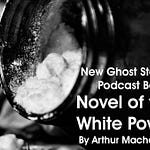You can listen and download the New Ghost Stories Podcast from a number of platforms.
William Hope Hodgson was not a writer who led a quiet scholarly life. At the age of 13 he attempted to run away from boarding school to join the navy. Though he was caught, he eventually convinced his father to allow him to take an apprenticeship as a cabin boy. In an eventful sea-faring career he was awarded the Royal Humane Society medal for heroism, after saving the life of a sailor who fell into shark-infested waters off the coast of New Zealand.
Because of his youth, he was often bullied by older seamen. To develop a more intimidating physique, he became interested in bodybuilding and physical training. At 22, he opened a ‘School of Physical Culture’ offering tailored exercise regimes for personal training. He counted the local Blackburn police amongst his clients.
Hodgson was not shy about publicity. When Houdini visited Blackburn, the police supplied the locks and chains for the climax of his great escapology act (he had already escaped from their prison as a publicity stunt). Hodgson applied the chains to Houdini with such force that the great escapologist later claimed he had been injured, and the locks had been jammed. It took 90 minutes for Houdini to escape, his clothes torn and his arms bloody. Much controversy followed, with both speaking out against the other in the local press.
It's worth noting that Houdini was known to stage these kinds of feuds, so it’s hard to be sure if there was any real animosity between them.
He struggled, however, to make a living from his physical training work and turned to writing fiction. He also gave lectures on his life at sea, accompanied by his own photography, and campaigned for better rights and working conditions for sailors.
His first story, The Goddess of Death, was published in 1904, and his first novel, The Boats of the Glen Carrig, appeared in 1907. His 1908 novel ‘The House on the Borderland’ (a personal favourite) is considered one of the first cosmic horror novels, while his 1912 book The Night Land is considered an early example of the dying-earth subgenre.
Despite critical acclaim, he struggled to make a living. To establish a series detective character, he created Carnacki, the Ghost-Finder. In each Carnacki tale, the detective recounts one of his old a cases, a mystery which may be caused by the spirits, or by a cunning, everyday human culprit.
Determined to do his part in the first world war, Hodgson received a commission as a lieutenant in the Royal Artillery. In 1916 he was thrown from a horse, suffering a serious head injury and a broken jaw. Despite receiving a mandatory discharge, he was determined to return to the field and re-enlisted as soon as he recovered. He died in Ypres in 1918 from the direct impact of an artillery shell.
It wasn’t until the 1930s that Hodgson’s work started to grow in esteem. Lovecraft described The Night Land as “one of the most potent pieces of macabre imagination ever written” while Terry Pratchett once described the House on the Borderland as “the Big Bang in my private universe as a science fiction and fantasy reader and, later, writer".
If you’d like to support the New Ghost Stories Podcast, please consider coming a patron at Patreon.com/newghoststories
New Ghost Stories Volume Three is out now in both ebook and paperback. Non-Kindle ebook formats are available from Smashwords.













Share this post